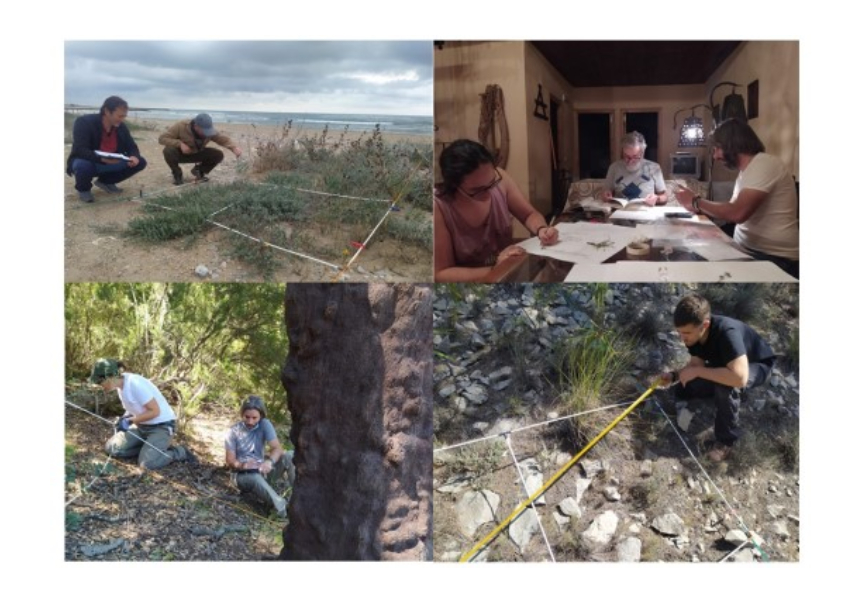
The Desertification Research Center (CIDE, CSIC-UV-GVA) coordinates this project in which 23 scientific institutions from the five continents are involved.
The data collected during 15 years on more than 3,300 species of vascular plants contribute to the knowledge of plant communities and ecosystems.
An international team led by scientists from the Consejo Superior de Investigaciones Científicas (CSIC) presents, for the first time, a global and open database of recruitment networks of different plant species across the planet. In the elaboration of this global map of plant interactions, published in the journal Ecology, scientific institutions from 23 countries of the five continents have participated under the coordination of Miguel Verdú, CSIC researcher at the Desertification Research Center (CIDE), a joint center of CSIC, the University of Valencia (UV) and the Generalitat Valenciana.
A recruitment network describes how plant species are related to each other in a plant community. Specifically, it describes which plants establish themselves under whom. These relationships do not occur randomly but follow a structured network of interactions between plants that have profound implications for the composition, diversity, structure and maintenance of plant communities in ecosystems.
The mechanisms underlying recruitment interactions (establishment of new plants under other species) are well known, but how recruitment networks structure ecological communities is less well understood. In this sense, the database constructed in this work brings together studies of 143 ecological networks of plant communities in 23 countries on five continents, including temperate and tropical ecosystems.
Each network identifies the adult plant of the species already established and those recruiting below it in a given community. All networks studied report the number of 'recruits' or new individuals per established species. All in all, the dataset includes more than 850,000 recruits involved in interactions among 3,318 vascular plant species worldwide.
This wealth of information, with a broad geographic spread, can be used to build models that describe how species associate in a given community and how certain species are more likely to be replaced by others, thereby affecting plant community stability and species coexistence.
"These models provide a valuable opportunity to understand the rules that govern the interactions between species in communities in natural ecosystems, and contribute to improving knowledge about the functioning and maintenance of ecosystems," explains Verdú.
A network of networks
The data collected are the result of the collaborative work of 97 researchers who have exchanged information, the result of 15 years of work analyzing plant interactions within a wide range of terrestrial plant communities, including forests, shrublands and grasslands. This has required the establishment of basic methodological guidelines to standardize sampling methods that could make future studies of these networks directly comparable.
Therefore, "this work has taught us that, as in plant communities where some collaborate with others in an extensive network of interactions, collaborative work between colleagues yields results that go far beyond the sum of individual efforts," concludes the CSIC researcher.
Reference:
Verdú, M., Garrido, J.L., Alcántara, J.M., Montesinos-Navarro, A., Aguilar, S., Aizen, M.A., Al-Namazi, A.A., Alifriqui, M., Allen, D., Anderson-Teixeira, K.J., Armas, C., Bastida, J.M., Bellido, T., Bonanomi, G., Briceño, H., Camargo, R., Campoy, J.G., Chaieb, G., Chu, C., Collins, S.E., Condit, R., Constantinou, E., Degirmenci, C.Ü., Delalandre, L., Duarte, M., Faife-Cabrera, M., Fazlioglu, F., Fernando, E.S., Flores, J., Flores-Olvera, H., Fodor, E., Ganade, G., Garcia, M., García-Fayos, P., Gavini, S.S., Goberna, M., Gómez-Aparicio, L., González-Pendás, E., González-Robles, A., Hubbell, S.P., Ipekdal, K., Jorquera, M.J., Kikvidze, Z., Kütküt, P., Ledo, A., Lendínez, S., Li, B., Liu, H., Lloret, F., López, R.P., López-García, Á., Lortie, C.J., Losapio, G., Lutz, J.A., Luzuriaga, A.L., Máliš, F., Manrique, E., Manzaneda, A.J., Marcilio-Silva, V., Michalet, R., Molina-Venegas, R., Navarro-Cano, J.A., Novotny, V., Olesen, J.M., Ortiz-Brunel, J.P., Pajares-Murgó, M., Parissis, N., Parker, G., Paterno, B.G., Perea, A.J., Pérez-Hernández, V., Pérez-Navarro, M., Pistón, N., Pizarro-Carbonell, E., Prieto, I., Prieto-Rubio, J., Pugnaire, F.I., Ramírez, N., Retuerto, R., Rey, P.J., Rodriguez-Ginart, D.A., Rodríguez-Sánchez, M., Sánchez-Martín, R., Schöb, C., Tavsanoglu, Ç., Tedoradze, G., Tercero-Araque, A., Tielbörger, K., Touzard, B., Tüfekcioglu, I., Turkis, S., Usero, F.M., Usta-Baykal, N., Valiente-Banuet, A., Vargas-Colin, A., Vogiatzakis, I., Zamora, R..2022. RecruitNet: A global database of plant recruitment networks. Ecology. 2022. DOI: 10.1002/ecy.3923.
CIDE Communication









